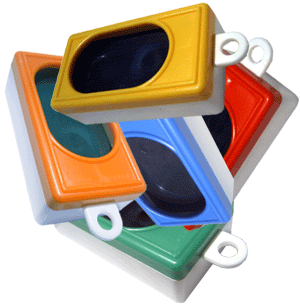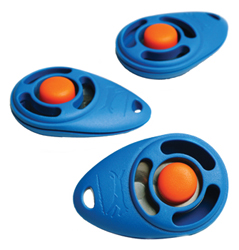Most puppies and kittens have a strong, natural desire to
investigate. But this curiosity can lead to problems when your pet tears up a
favorite houseplant or destroys your new shoes. Many owners rely solely on
punishment to correct problem behavior, but you'll find that reinforcing good
behavior works better and keeps your pet happier. You can do this easily by
giving your puppy or kitten a place where he can explore and investigate and by
giving him safe, interesting chew toys.
Do not leave your puppy or kitten loose in the house or yard unsupervised. This will
inevitably lead to destructive behavior. Crate training is recommended for all
dogs and is not a bad idea for cats either (but you need to provide enough room
for a litter box). A dog crate or exercise pen should be used until you can
trust that the pet knows the house rules.
Chew Toys
* Begin with a variety of toys and determine which types your pet prefers.
*Rotate different toys to keep them novel and interesting.
Reward your pet when it chews its toys.
*Never give items to the pet to chew that are similar to household items you don't want destroyed. (e.g., your puppy may not distinguish between old shoes and new shoes.)
*Use commercial anti-chew sprays (Bitter Apple Spray), citronella oil, or a small amount of cayenne pepper mixed with water on items you don't want chewed as deterrents.
Punishment for chewing is not a good solution since it can cause your puppy or kitten to
fear you. At best, it may only teach him not to chew the items when you are
watching. He may hide from you while chewing, run away when you try to remove the item or even swallow the item. You may even cause worse behavior in the pet such as 'resource guarding' where the animal growls, snaps, claws or bites to keep you away from their prize.
Prevention is key! Keep your puppy on a leash (~ 6 feet long) when you are home
and interrupt the chewing behavior by calling him to you and rewarding him, or
redirecting the chewing the appropriate toy. Or better yet, teach your dog to
bring you the toy and reward them with a treat. This is the most effective way
to discourage chewing. Instead of learning to run away with the item to chew it
up, the pup will learn to bring you any item it finds so it will get a reward.
With kittens, keep them in the same room with you until you
are sure they will not chew on things they shouldn't. Teach them to come when
called and reward that behavior. You can also redirect them with an appropriate
toy or treat. Shooing cats away and startling them to get them to leave
something alone or get off a surface usually only teaches the cat to avoid the
object or area when you are present. They have no problem going right back to
it once you aren't paying attention. They also learn that you aren't
trustworthy and become more difficult to catch.
Destructive behavior is often a direct response to anxiety. It is not your pet's
attempt to get even with you. Extreme anxiety and destructiveness during your
absence may require an in-depth behavior consultation. If you have a problem,
please call us.
Some pets develop a habit called Pica, where they
not only chew things they shouldn't, but they eat them as well. This can be
very dangerous for your pet.
What is Pica?
Pica is the act of eating non-food items. In less serious cases, pets may chew or suck
on objects, but not actually swallow them. Common targets include yarn or
string, fabric, wool, phone or electric cords, and plants. Any object may be a
potential target, however.
Why is Pica Dangerous?
Other than its destructive potential, pica can be extremely hazardous to your pet's
health if non-food items are consumed. Ingested fabric, string, or other
materials can lodge in your pet's stomach or intestine. The blockage prevents
the passage of food and may cut off the blood supply to these organs. Both are
life-threatening conditions. Pet's that chew on power cords may be electrocuted.
Additionally, many common houseplants are toxic to animals; chewing or eating
these plants can cause a wide range of symptoms from drooling to death. If your
pet has a history of ingesting non-food items and becomes lethargic, vomits, or
displays other concerning behavior, call your veterinarian for an appointment immediately.
Why Does My Pet Eat/Chew on Non-food Items?
No one knows exactly why some animals exhibit pica behavior. Because pica has been
associated with a variety of diseases including feline leukemia and feline
immunodeficiency virus in cats, a veterinarian should examine any animal with
pica. A genetic component is also suspected since wool or fabric
sucking/chewing is more commonly found in Oriental breeds such as Siamese cats.
Although it is normal for cats and dogs to eat small amounts of grass,
consumption of large amounts of plant material may be an indication of a
dietary deficiency or illness. Once medical causes are ruled out, behavioral
reasons for pica can include boredom, attention-seeking, attractive odors,
hunger, and learned behavior.
Treatment:
To rule out medical causes, a veterinarian should examine all pets displaying pica. Once
your pet has a clean bill of health, we will discuss what steps you can take to
modify your pet's behavior. These may include the following:
1. Remove targeted items - Placing clothing, blankets, houseplants and electric cords out of the reach
of your pet is often the easiest solution. Storage containers, electric cord guards, and other useful items are available at most home supply stores.
2. Provide alternative items to chew or eat - Food-dispensing toys, durable toys, or pieces of rawhide
can be used to redirect your pet's chewing behavior to more appropriate and
safe items. For pets attracted to houseplants, small flowerpots of grass or
catnip can be planted and kept indoors. Birdfeed can be used as a safe source
of plant seed.
3.Provide lots of structured play - Many pets chew on household items out of boredom. Provide
interactive toys and set aside time each day to play with your pet.
4. Make targeted items aversive - Occasionally, applying aversive substances (e.g. hot sauce, Bitter
Apple, Bandguard to an item may deter a pet from
chewing it. If this is not possible, spraying strong smelling substances (e.g.
citrus air freshener, potpourri) or using physical deterrents (e.g. upside down
carpet runner, Ssscat, Snappy Trainers) around an
object may prevent pets from approaching.
Most chewing behavior in pets is natural, especially in puppies and kittens. We have
to teach our young pets what is appropriate to chew on and what is not. They
learn just like human children, through trial and error. If inappropriate
chewing behavior continues into adulthood, it can cause unnecessary strife in
the household. Please call us if you need help with your pet's destructive
chewing.















